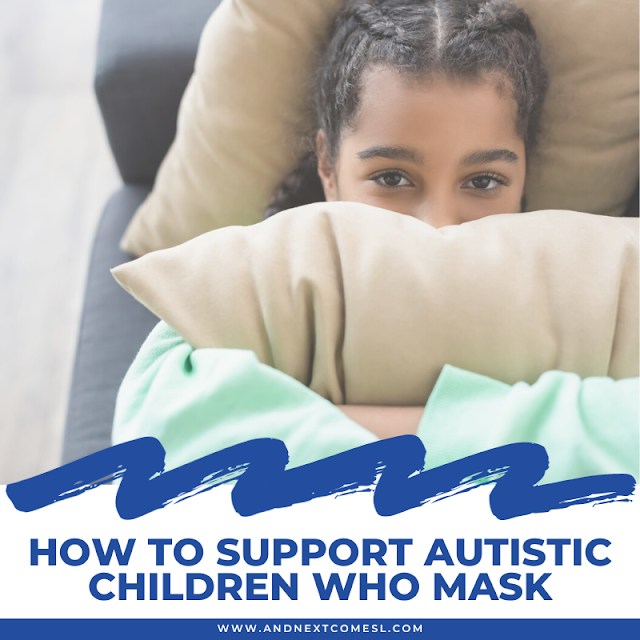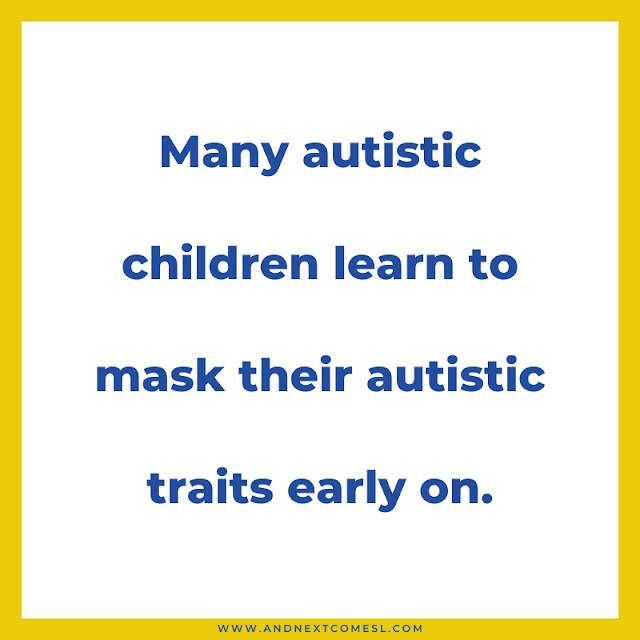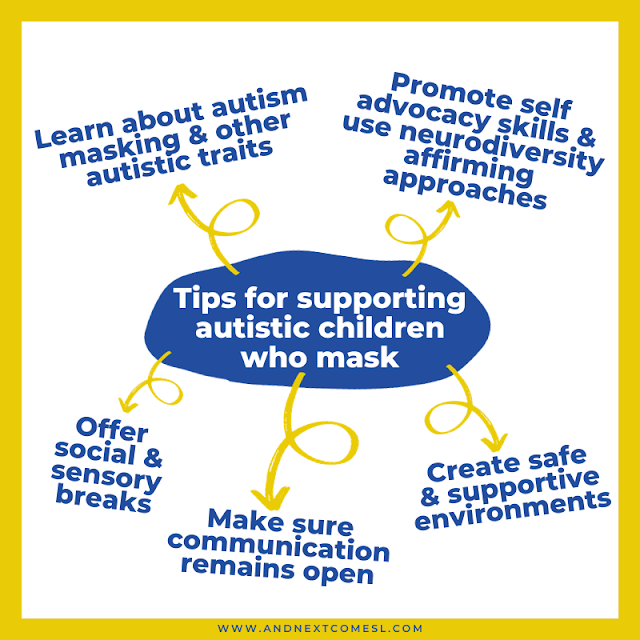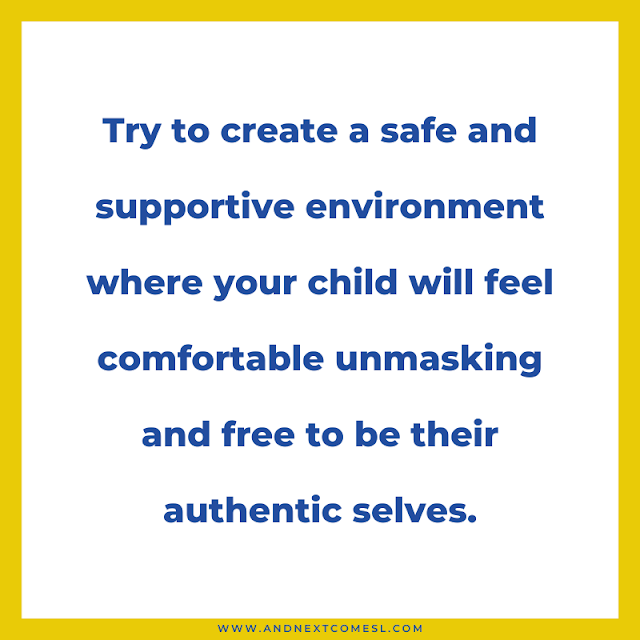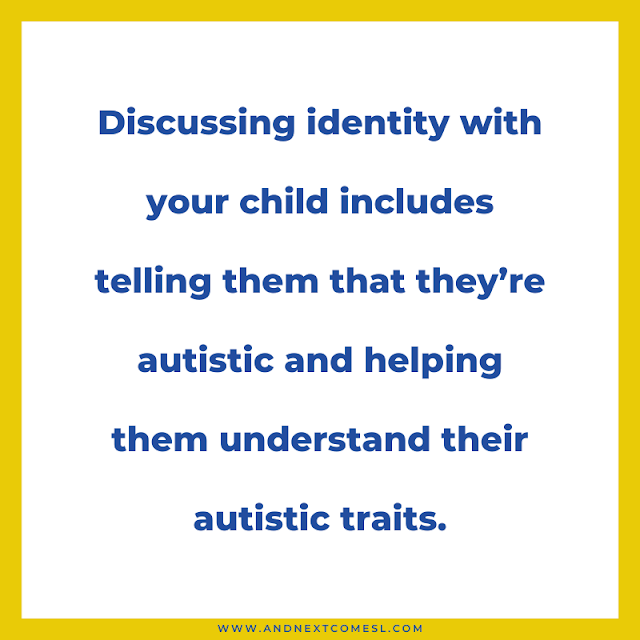As you may already know, many autistic children learn to mask their autistic traits quite early on. They might do it as a way to fit in or to feel a sense of belonging, for instance (more reasons why here).
But you also know that autistic masking can have negative long term effects...Too much masking can lead to bigger problems down the road.
Yet, perhaps you also recognize that there are times where masking might be extremely important to engage in. For instance, in matters of personal safety.
So what can parents or caregivers do? How do you balance the short term benefits of autistic masking with the long term consequences?
Below we'll discuss tips and strategies for how to support autistic children who mask. That way you know what you can do at home, at school, during therapy, or in other environments.
How to Support Autistic Children who Mask
There are a variety of things you can do to make sure your autistic child feels well supported and safe enough to unmask. The tips usually fall into one of these broader categories:
- Learning about autism masking and other autistic traits
- Creating safe and supportive environments
- Promoting self advocacy skills and using neurodiversity affirming approaches
- Offering social and sensory breaks
- Making sure communication remains open
But let's break these categories down into more specific tips and strategies that you can actually use.
1. Learn About Autism Masking & Other Autistic Traits
The best place to start is by educating yourself about autistic masking (much like you're already doing!) and other autistic traits. That includes learning about stimming, meltdowns, infodumping, special interests, etc.
Once you have a better understanding of what autistic masking is, then you can better educate those around you, including family members, anyone who works with your child, the school, and so on.
For example, you will want to work with your child's teacher and the school to make sure they are familiar with masking. They'll also need to know what signs of autism masking at school to watch out for. Maybe you can work together to come up with strategies to ensure that the classroom is a safe space for your child to be their true authentic self.
You'll also want to watch out for any masking behaviors that are being taught to your child during therapy. They may be taught inadvertently or not.
Please keep in mind that a lot of social skills programs and ABA therapy, for instance, teach a lot of masking behaviors. So opt for more neurodiversity affirming approaches and therapies (we'll touch on this more below).
2. Create Safe & Supportive Environments for Your Autistic Child
Whether at home or in the classroom, you want to try and create a safe and supportive environment. One where your child will feel comfortable unmasking and free to be their authentic selves.
But how do you do that exactly?
Well, start by creating a sensory safe space, such as calm down corner, or by offering fidgets or other sensory tools that the child finds helpful.
You'll also want to focus on creating an inclusive environment. One where differences are celebrated and validated. That might mean tweaking the language you use, shifting your mindset, encouraging stimming and infodumping, taking a strengths-based approach to things, and never ever shaming them for their autistic traits.
You can also provide supports and accommodations for those times when using spoken language might be too hard to access. That might mean using visual aids, AAC tools, communication cards, or similar.
Another thing you can do is provide predictability and create strong routines. Big or unexpected changes can often be a reason why a child might mask so making the environment as predictable and routine based as possible can be super helpful.
For example, maybe you always have tacos on Tuesdays, baths on Wednesdays, or movie nights on Fridays. Maybe you always have music class on Tuesdays and Thursdays. Keeping those routines provide stability because they are predictable and familiar. The child knows what to expect and when. And when things are predictable, masking won't be as likely or as necessary.
3. Promote Self Advocacy Skills & Use Neurodiversity Affirming Approaches
One of the best things - hands down - that you can teach your autistic child is self advocacy skills.
Teaching a child how to speak up and advocate for themselves is empowering and useful. It can also boost self-esteem and confidence.
You'll also want to look for and use neurodiversity affirming approaches. Remember, as was touched on earlier, a lot of therapies and professionals might inadvertently be teaching masking behaviors to your child.
Neurodiversity affirming approaches, on the other hand, create environments that are safer for kids to be themselves. As a result, you'll notice that children won't have to rely on masking as much or as often.
But what does neurodiversity affirming mean exactly? What does it look like? Well, it means encouraging special interests and stimming. It means considering the child's sensory needs and understanding that echolalia is meaningful communication. It also means aiming for connection over compliance, teaching self advocacy skills, recognizing that all forms of communication are valid, and so on.
4. Offer Social & Sensory Breaks
Autistic children who mask need regular breaks. So be sure to encourage and allow for social and sensory breaks. That might mean taking breaks from or during social interactions, setting aside downtime after school, going for sensory breaks during the school day, or a combination of all of the above.
You'll also want to teach your child that it's okay to take a break. Then help them learn about their own sensory and social triggers and identify what strategies they can use to regulate, when needed.
Be sure to also teach your child about monitoring their energy levels (or spoons in the disability community!). That way they can know when it's time to take a break, use a coping strategy, etc.
You should also be modeling things like the value of taking a break, resetting after a long day, enjoying hobbies, and so on. That way your child can see that it's okay for everyone to take breaks when they need it.
The main point here is to give your child time and space.
That might be in a calm down space or corner, like we discussed earlier, or just giving them some downtime after school.
That might also mean letting them engage with passions or special interests (tips and strategies here).
Basically, you want to give them time to recharge their battery. Speaking of which, this free self care battery printable might be a helpful tool for your child.
Another idea is to reduce demands and consider whether or not the situation you are placing them in is increasing the need for masking. For instance, does your child really need to take part in that particular social activity? Do they really need to wear the fancy outfit to your cousin's wedding? Can they give their grandma a high five instead of a hug?
Another thing to keep in mind is that it's important to meet the child where they're at. Ask fewer questions, place fewer demands, help them regulate through co-regulation, provide them with breaks, socialize for shorter periods of time...do what you can to support the child you have right now.
5. Make Sure Communication Stays Open
In terms of communication, there are lots of different strategies that you can try.
First of all, talk to your child about autistic masking and unmasking. Help them understand what it is, why it might be helpful in certain situations, the effects of long-term masking, when to mask and when not to, how to unmask, the benefits of unmasking, and so on.
Secondly, watch out for changes in your autistic child so that you can talk to them about any changes you're noticing.
For example, perhaps you've noticed some signs of autistic masking or your child's teacher has noticed some at school. Or maybe you've noticed mood or behavior changes or some signs of burnout. Maybe you've even noticed that your child is no longer into that special interest they've loved for so long.
Another thing you can do is advocate for your child in other environments such as school. Especially when they are younger or when they are finding it difficult to advocate for themselves. This also includes educating the school or others about autistic masking so they too can know how to support your child. Remember, your child will pick up on what you model.
Finally, you'll want to make sure you talk to your child about identity in general and discuss any identity issues that your child might be facing.
Discussing identity includes talking about strengths, interests and hobbies, differences, inclusion, gender identity, sexual identity, and so on.
It also includes telling them that they're autistic, helping them understand autistic traits and culture, teaching them vocabulary related to neurodiversity, making sure they understand what masking is, and so on.
Recap of Autism Masking & Supporting the Kids who Mask
Okay, I know that was a lot of information. So, here's a quick summary of supporting autistic kids who mask:
- Educate yourself and others about autistic masking and other autistic traits
- Make sure the child's teacher and the school are familiar with autism masking
- Watch out for masking behaviors that are being taught during therapy
- Create a safe and supportive environment
- Create an inclusive environment
- Celebrate differences
- Provide supports and accommodations
- Create strong routines
- Promote self advocacy skills
- Use neurodiversity affirming approaches
- Offer social and sensory breaks
- Teach kids that it's okay to take a break
- Model taking a break, resetting after a long day, etc.
- Give kids time and space to reset and decompress
- Encourage a child's interests and passions
- Reduce demands
- Meet the child where they're at
- Talk to the child about autistic masking and unmasking
- Talk to the child about any changes you've noticed
- Advocate on behalf of the child
- Discuss identity, inclusion, and differences with kids
By now, you should feel more confident that you know how to support autistic children who mask. After all, you now have a long list of tips and strategies to consider and try.


